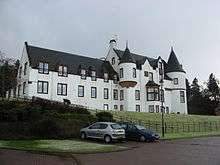William Leiper
William Leiper FRIBA RSA (1839-1916) was a Scottish architect notable particularly for his domestic architecture in and around the town of Helensburgh.[1] In addition, he produced a small amount of fine ecclesiastical and commercial architecture in Glasgow and the Scottish Lowlands. He was also an accomplished watercolour artist, and in the late 1870s, took a break from architecture to pursue painting. He lived the last 40 years of his life in Helensburgh, at 'Terpersie', and died there on 27 May 1916.


Early life
Leiper was born in Glasgow and educated at Glasgow High School. From the mid to late 1850s, he trained with local architectural firm Boucher & Cousland before competing his training in London with W White and JL Pearson.[1] By 1864, he had returned to Glasgow and was in partnership for three years with Robert Grieve Melvin.
Career
A turning point in Leiper's career came in 1864 when, aged 26, he won the commission to build Dowanhill Church[2] in Glasgow's Hyndland.
In his native Glasgow, Leiper was responsible for Templeton's Carpet Factory and the Sun Life Building on West George Street, which housed Alexander Reid's famous art gallery, the banqueting hall of Glasgow City Chambers as well as a number of churches.[1] He also had a reputation for designing residential properties in the city and nearby. His notable works are primarily part of the Arts and Crafts Movement or in the Gothic Revival style.[3]
Leiper was responsible for the design of St Columba's Church and Auchenbothie House in the village of Kilmacolm, Renfrewshire, and a number of works in Helensburgh, Dunbartonshire.[1] One of his residential commissions became the most expensive house sold in the latter town in 2008.[3]
He also worked on the interior of the Russian imperial yacht, Livadia.[1]
References
- William Leiper Retrieved 2 July 2018.
- Dowanhill Church, Glasgow, by William Leiper
- Rod Liddle (14 October 2018). "The Times & The Sunday Times". Property.timesonline.co.uk. Retrieved 20 January 2019.